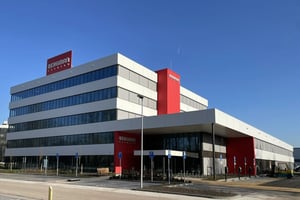In the wake of the digital revolution, we’re living in a far more volatile world than ever before, INSEAD professor and supervisory board member Annet Aris recently told ManagementScope magazine. A growing number of traditional organisations have trouble managing that volatility, which manifests itself in rapidly changing market conditions and customer needs. Various leadership experts argue that changing the way we work and adopting a different type of leadership style could be the solution. Discover how organisations based on ‘Adaptive Leadership’ transform themselves in such a way as to deal with multiplicity, simultaneity, uncertainty and vulnerability.
“We do not live in an era of change, but in a change of era.” This pronouncement by Jan Rotmans, lecturer in Transition Studies at Erasmus University Rotterdam, describes a development that is sure to resonate with many leaders. New ideas are emerging left and right and at an unprecedented rate, and a single new technology has the power to transform an entire industry. Formerly stable and reliable markets are collapsing seemingly overnight as a result of changing consumer needs and disruptive new business models.
Many traditional organisations are trying to find answers in an economy that is undergoing a radical and permanent transformation. According to Lukas Straathof, co-founder of adaptive leadership-based company Today Is Not Tomorrow, ‘old-school’ solutions no longer do the trick, and organisations intending to be successful in the future will need to adapt to the dynamics of the unknown. “They must be able to deal with what I like to call ‘adaptive problems,’ which is to say: problems you might compare to a plate of cold spaghetti, where you pull out one strand and the rest will follow automatically.”
According to Straathof’s colleague and co-owner Inez Bosch, organisations – notwithstanding widely embraced methodologies such as Agile, Lean, self-directed teams, and so on – are more often than not unable to achieve lasting change. “When this change is, in fact, necessary to be able to anticipate customers’ needs more effectively, as well as for promoting innovation and cost savings,” Bosch says. “We are noticing that companies are investing considerable time and effort in changing their organisational structures and introducing new work formats, procedures, positions and meeting structures. While these types of ‘technical’ changes can be implemented relatively securely, they seldom lead to any lasting change. In that sense, it’s a bit like a bowl of wax that you heat up and stir around, only to have it start to thicken again soon after.”
High-risk strategy
In order to remain agile, organisations “must start changing their mindsets and behaviour,” Straathof says. “They are challenged by a variety of interrelated problems at the same time: the proliferation of new technologies, the digital revolution, sustainability, climate change and political instability – to name but a handful. That calls for the type of leadership that can deal with multiplicity, simultaneity, uncertainty and vulnerability. The old reflex of reducing uncertainty through rules, procedures and scenarios no longer cuts it.”
Annet Aris, member of the supervisory boards of Rabobank, ASML, Randstad and other companies, believes that organisations need to start changing their strategies. As she told ManagementScope magazine in a recent interview: “What the world will look like two decades from now is so uncertain that trying to develop scenarios at this stage would be a fool’s errand. I do believe, however, that it’s important for supervisory board members to prepare their companies for any number of scenarios. You need to set up your processes and procedures in such a way that your business can deal with uncertainty. I think that’s really one of the most pressing issues right now: how much do we invest in certainties, and how much in options? Jumping the gun by thinking: “Trend X is the way of the future, so let’s start investing heavily in X right now’ is a strategy that’s fraught with risk in this day and age.”
Hive mind
Bosch feels organisations need to start working on changing their employees’ mindsets. This means workers should be assessed not just on knowhow and experience, but also based on their capacity for self-reflection, listening skills, intuitive ability and the ability to tap into the ‘hive mind’ – the group’s collective intelligence, if you will. “In other words, the kind of mindset that’s required to come up with original, unexpected and groundbreaking ideas in situations of uncertainty,” Bosch says. “That means less control and less hierarchy, both phenomena that are linked primarily to our need for cognitive disclosure. That is to say: our innate dislike of ambiguity and our natural preference for solid, affirmative truths. Instead, we need to learn to be more active and rely on our personal problem-solving compass.”
Straathof stresses that ‘less control’ does not equate to embracing total chaos: “All it means is adopting a different mindset, one that lets you move away from automatically relying on strategic multi-year plans, a strict organisational hierarchy and a set of standard operating procedures. By having confidence in your employees’ talent, expertise and customer knowledge and by giving them responsibility and ownership, you can learn to manage uncertainty and complexity in a way that is both creative and successful.”
Also read: ‘Design thinking: innovation 2.0’













